YAMAHA WOLVERINE 2018 Repair Manual
Manufacturer: YAMAHA, Model Year: 2018, Model line: WOLVERINE, Model: YAMAHA WOLVERINE 2018Pages: 188, PDF Size: 5.4 MB
Page 61 of 188
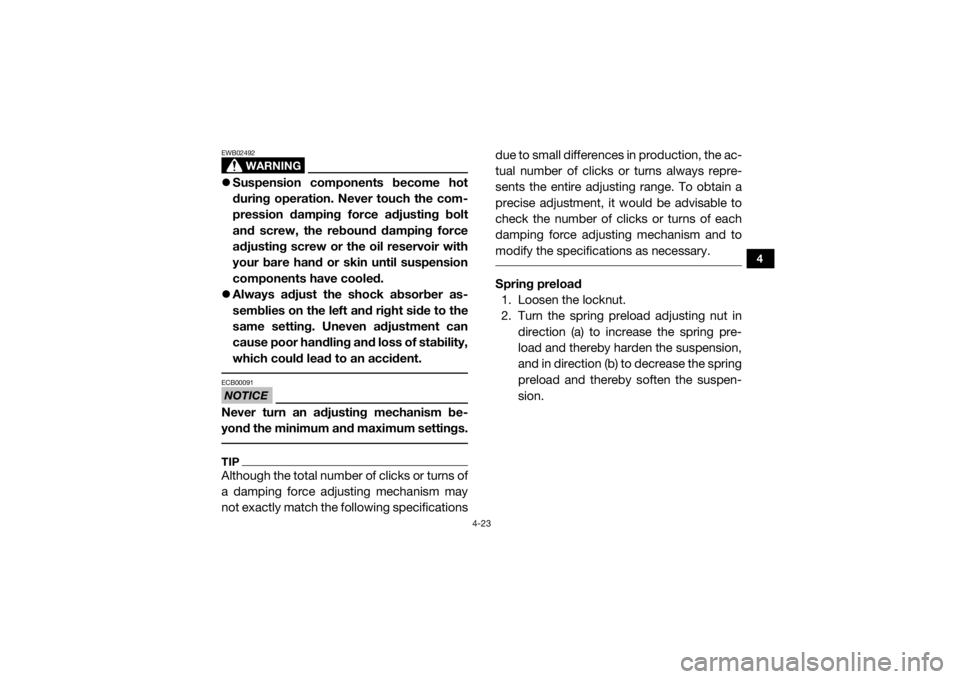
4-23
4
WARNING
EWB02492Suspension components become hot
during operation. Never touch the com-
pression damping force adjusting bolt
and screw, the rebound damping force
adjusting screw or the oil reservoir with
your bare hand or skin until suspension
components have cooled.
Always adjust the shock absorber as-
semblies on the left and right side to the
same setting. Uneven adjustment can
cause poor handling and loss of stability,
which could lead to an accident. NOTICEECB00091Never turn an adjusting mechanism be-
yond the minimum and maximum settings. TIPAlthough the total number of clicks or turns of
a damping force adjusting mechanism may
not exactly match the following specifications due to small differences in production, the ac-
tual number of clicks or turns always repre-
sents the entire adjusting range. To obtain a
precise adjustment, it would be advisable to
check the number of clicks or turns of each
damping force adjusting mechanism and to
modify the specifications as necessary.
Spring preload
1. Loosen the locknut.
2. Turn the spring preload adjusting nut in direction (a) to increase the spring pre-
load and thereby harden the suspension,
and in direction (b) to decrease the spring
preload and thereby soften the suspen-
sion.
UB3D7AE0.book Page 23 Tuesday, November 7, 2017 9:38 AM
Page 62 of 188
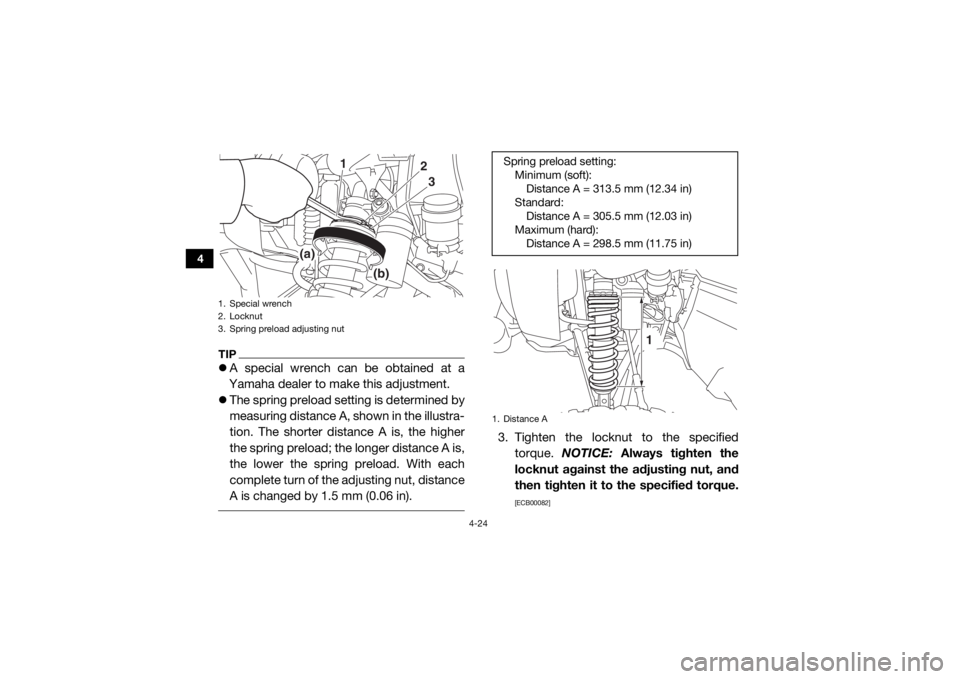
4-24
4
TIPA special wrench can be obtained at a
Yamaha dealer to make this adjustment.
The spring preload setting is determined by
measuring distance A, shown in the illustra-
tion. The shorter distance A is, the higher
the spring preload; the longer distance A is,
the lower the spring preload. With each
complete turn of the adjusting nut, distance
A is changed by 1.5 mm (0.06 in).
3. Tighten the locknut to the specified
torque. NOTICE: Always tighten the
locknut against the adjusting nut, and
then tighten it to the specified torque.
[ECB00082]
1. Special wrench
2. Locknut
3. Spring preload adjusting nut
2
1
3
(a)
(b)
Spring preload setting: Minimum (soft):Distance A = 313.5 mm (12.34 in)
Standard: Distance A = 305.5 mm (12.03 in)
Maximum (hard): Distance A = 298.5 mm (11.75 in)1. Distance A
1
UB3D7AE0.book Page 24 Tuesday, November 7, 2017 9:38 AM
Page 63 of 188
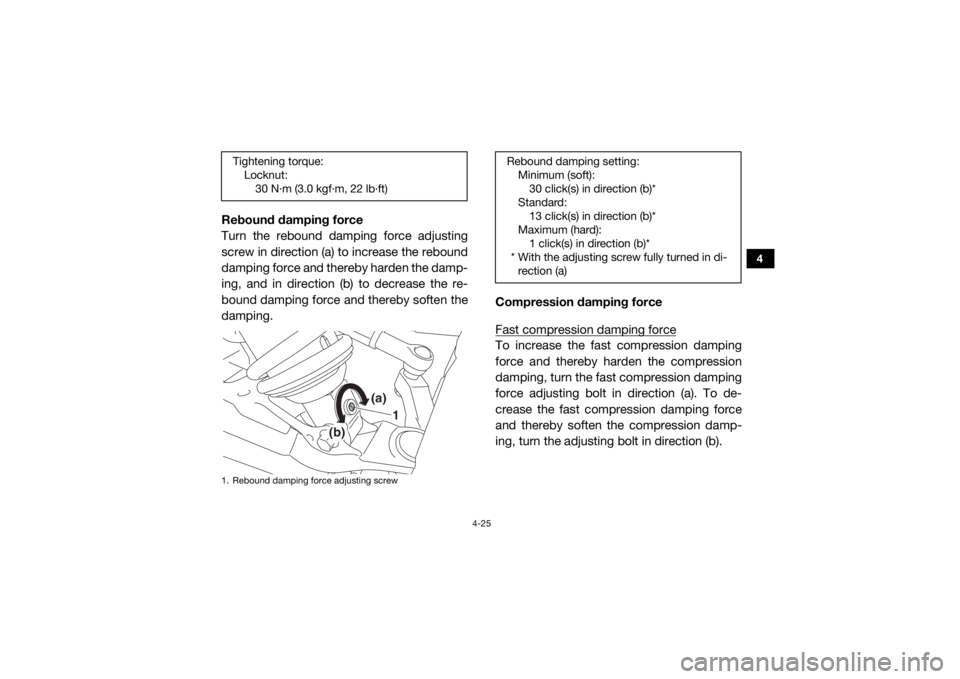
4-25
4
Rebound damping force
Turn the rebound damping force adjusting
screw in direction (a) to increase the rebound
damping force and thereby harden the damp-
ing, and in direction (b) to decrease the re-
bound damping force and thereby soften the
damping.Compression damping force
Fast compression damping force
To increase the fast compression damping
force and thereby harden the compression
damping, turn the fast compression damping
force adjusting bolt in direction (a). To de-
crease the fast compression damping force
and thereby soften the compression damp-
ing, turn the adjusting bolt in direction (b).
Tightening torque:
Locknut:30 N·m (3.0 kgf·m, 22 lb·ft)1. Rebound damping force adjusting screw
1
(a)
(b)
Rebound damping setting: Minimum (soft):30 click(s) in direction (b)*
Standard: 13 click(s) in direction (b)*
Maximum (hard): 1 click(s) in direction (b)*
* With the adjusting screw fully turned in di- rection (a)
UB3D7AE0.book Page 25 Tuesday, November 7, 2017 9:38 AM
Page 64 of 188

4-26
4
Slow compression damping forceTo increase the slow compression damping
force and thereby harden the compression
damping, turn the slow compression damp-
ing force adjusting screw in direction (a). To
decrease the slow compression damping for-
ce and thereby soften the compression
damping, turn the adjusting screw in direction
(b).
1. Fast compression damping force adjusting boltFast compression damping force settings:Minimum (soft):2 turn(s) out from the fully turned in posi-
tion
Standard: 1 1/4 turn(s) out from the fully turned in
position
Maximum (hard): Adjusting bolt fully turned in
1(a)
(b)
1. Slow compression damping force adjusting screw
1(a)
(b)
UB3D7AE0.book Page 26 Tuesday, November 7, 2017 9:38 AM
Page 65 of 188
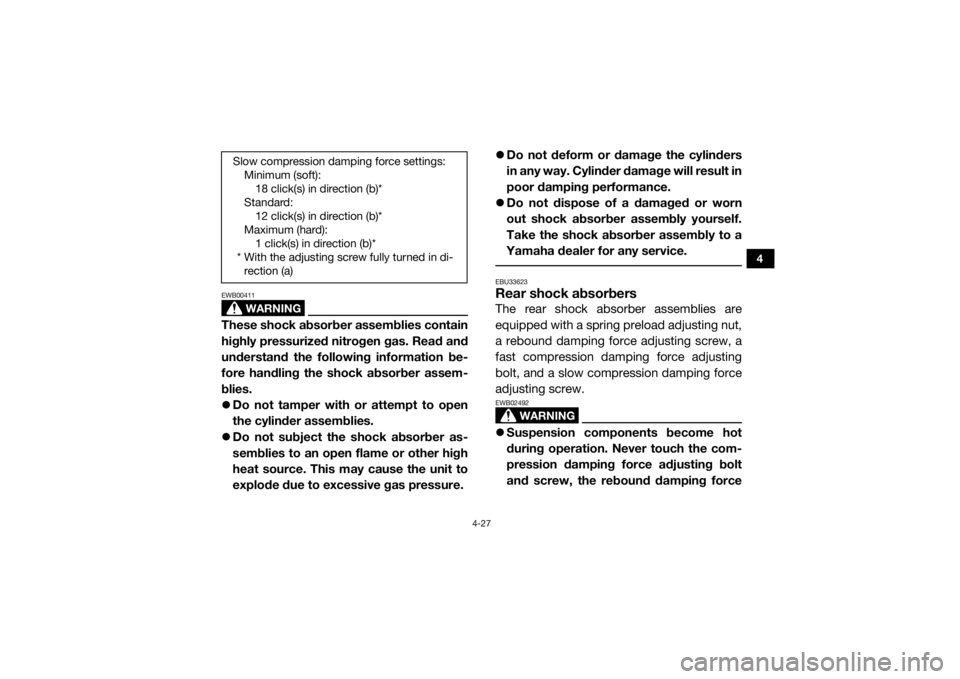
4-27
4
WARNING
EWB00411These shock absorber assemblies contain
highly pressurized nitrogen gas. Read and
understand the following information be-
fore handling the shock absorber assem-
blies.
Do not tamper with or attempt to open
the cylinder assemblies.
Do not subject the shock absorber as-
semblies to an open flame or other high
heat source. This may cause the unit to
explode due to excessive gas pressure.
Do not deform or damage the cylinders
in any way. Cylinder damage will result in
poor damping performance.
Do not dispose of a damaged or worn
out shock absorber assembly yourself.
Take the shock absorber assembly to a
Yamaha dealer for any service.
EBU33623Rear shock absorbersThe rear shock absorber assemblies are
equipped with a spring preload adjusting nut,
a rebound damping force adjusting screw, a
fast compression damping force adjusting
bolt, and a slow compression damping force
adjusting screw.
WARNING
EWB02492 Suspension components become hot
during operation. Never touch the com-
pression damping force adjusting bolt
and screw, the rebound damping force
Slow compression damping force settings:
Minimum (soft):18 click(s) in direction (b)*
Standard: 12 click(s) in direction (b)*
Maximum (hard): 1 click(s) in direction (b)*
* With the adjusting screw fully turned in di- rection (a)
UB3D7AE0.book Page 27 Tuesday, November 7, 2017 9:38 AM
Page 66 of 188
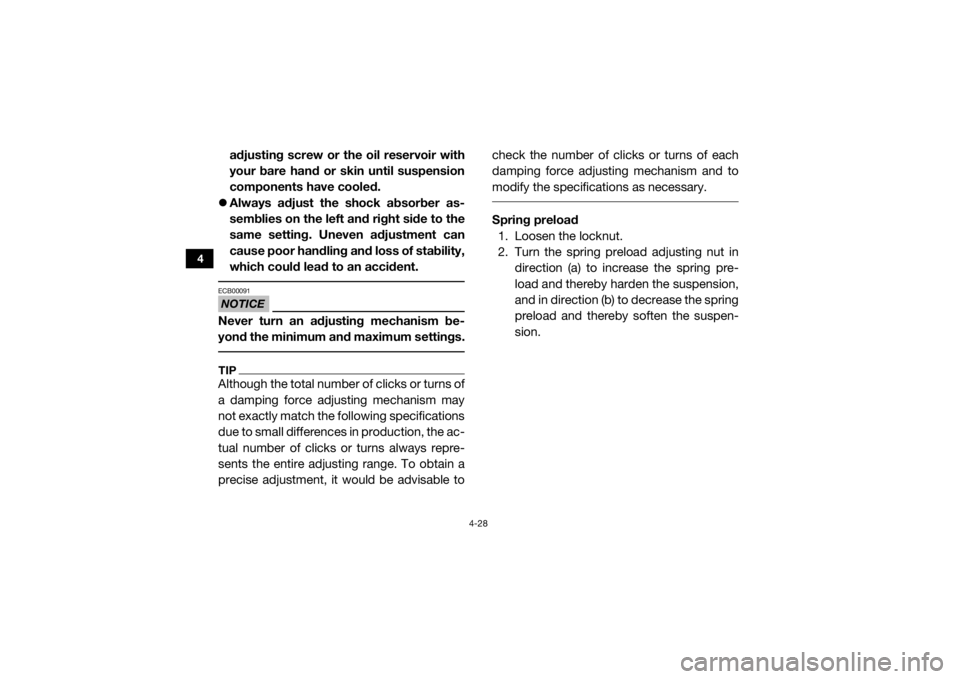
4-28
4
adjusting screw or the oil reservoir with
your bare hand or skin until suspension
components have cooled.
Always adjust the shock absorber as-
semblies on the left and right side to the
same setting. Uneven adjustment can
cause poor handling and loss of stability,
which could lead to an accident. NOTICEECB00091Never turn an adjusting mechanism be-
yond the minimum and maximum settings. TIPAlthough the total number of clicks or turns of
a damping force adjusting mechanism may
not exactly match the following specifications
due to small differences in production, the ac-
tual number of clicks or turns always repre-
sents the entire adjusting range. To obtain a
precise adjustment, it would be advisable to check the number of clicks or turns of each
damping force adjusting mechanism and to
modify the specifications as necessary.
Spring preload
1. Loosen the locknut.
2. Turn the spring preload adjusting nut in direction (a) to increase the spring pre-
load and thereby harden the suspension,
and in direction (b) to decrease the spring
preload and thereby soften the suspen-
sion.
UB3D7AE0.book Page 28 Tuesday, November 7, 2017 9:38 AM
Page 67 of 188
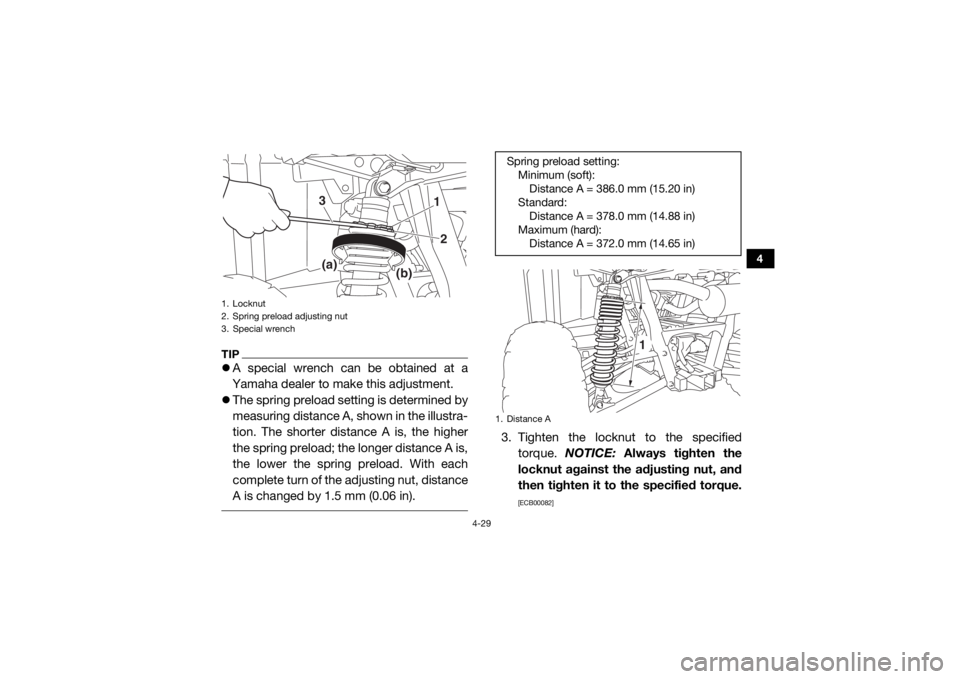
4-29
4
TIPA special wrench can be obtained at a
Yamaha dealer to make this adjustment.
The spring preload setting is determined by
measuring distance A, shown in the illustra-
tion. The shorter distance A is, the higher
the spring preload; the longer distance A is,
the lower the spring preload. With each
complete turn of the adjusting nut, distance
A is changed by 1.5 mm (0.06 in).
3. Tighten the locknut to the specified
torque. NOTICE: Always tighten the
locknut against the adjusting nut, and
then tighten it to the specified torque.
[ECB00082]
1. Locknut
2. Spring preload adjusting nut
3. Special wrench
1
3
2
(a)
(b)
Spring preload setting: Minimum (soft):Distance A = 386.0 mm (15.20 in)
Standard: Distance A = 378.0 mm (14.88 in)
Maximum (hard): Distance A = 372.0 mm (14.65 in)1. Distance A
1
UB3D7AE0.book Page 29 Tuesday, November 7, 2017 9:38 AM
Page 68 of 188
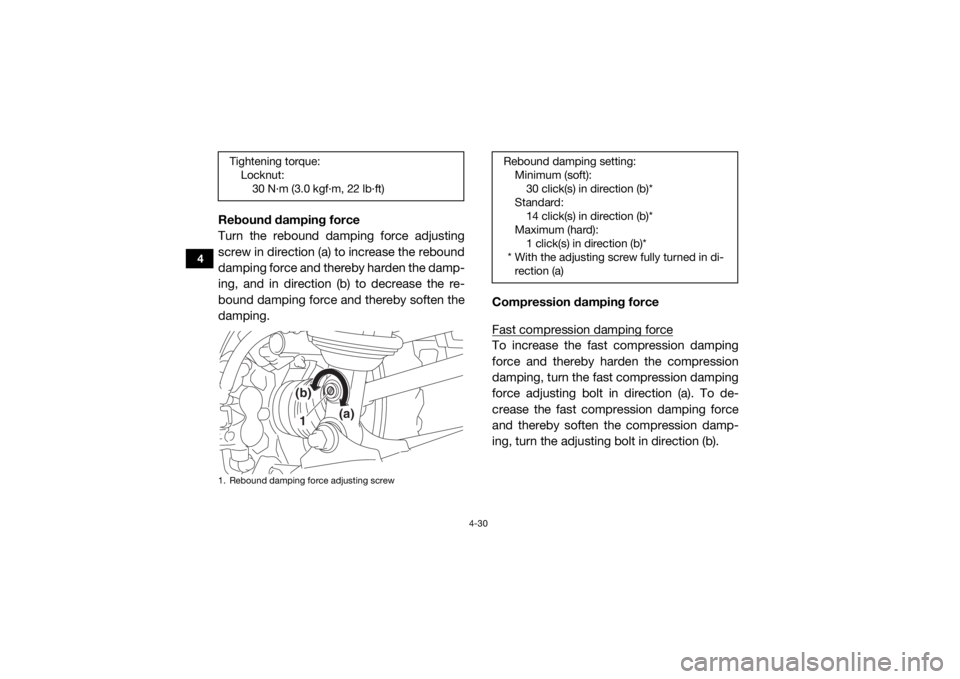
4-30
4
Rebound damping force
Turn the rebound damping force adjusting
screw in direction (a) to increase the rebound
damping force and thereby harden the damp-
ing, and in direction (b) to decrease the re-
bound damping force and thereby soften the
damping.Compression damping force
Fast compression damping force
To increase the fast compression damping
force and thereby harden the compression
damping, turn the fast compression damping
force adjusting bolt in direction (a). To de-
crease the fast compression damping force
and thereby soften the compression damp-
ing, turn the adjusting bolt in direction (b).
Tightening torque:
Locknut:30 N·m (3.0 kgf·m, 22 lb·ft)1. Rebound damping force adjusting screw
1
(a)
(b)
Rebound damping setting:Minimum (soft):30 click(s) in direction (b)*
Standard: 14 click(s) in direction (b)*
Maximum (hard): 1 click(s) in direction (b)*
* With the adjusting screw fully turned in di- rection (a)
UB3D7AE0.book Page 30 Tuesday, November 7, 2017 9:38 AM
Page 69 of 188
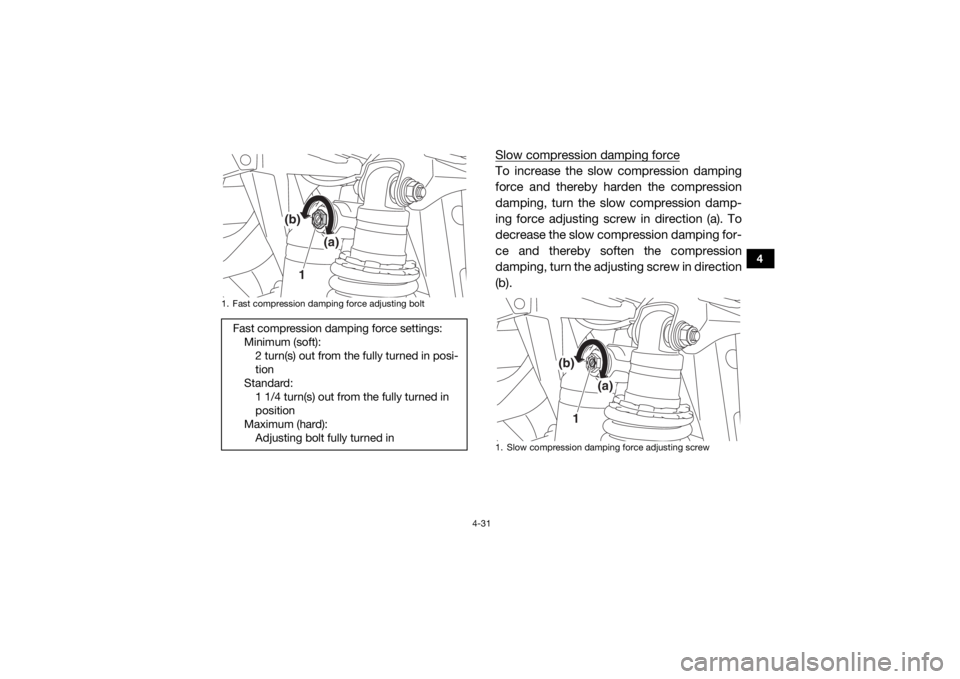
4-31
4
Slow compression damping forceTo increase the slow compression damping
force and thereby harden the compression
damping, turn the slow compression damp-
ing force adjusting screw in direction (a). To
decrease the slow compression damping for-
ce and thereby soften the compression
damping, turn the adjusting screw in direction
(b).
1. Fast compression damping force adjusting boltFast compression damping force settings:Minimum (soft):2 turn(s) out from the fully turned in posi-
tion
Standard: 1 1/4 turn(s) out from the fully turned in
position
Maximum (hard): Adjusting bolt fully turned in
1
(a)
(b)
1. Slow compression damping force adjusting screw
1
(a)
(b)
UB3D7AE0.book Page 31 Tuesday, November 7, 2017 9:38 AM
Page 70 of 188
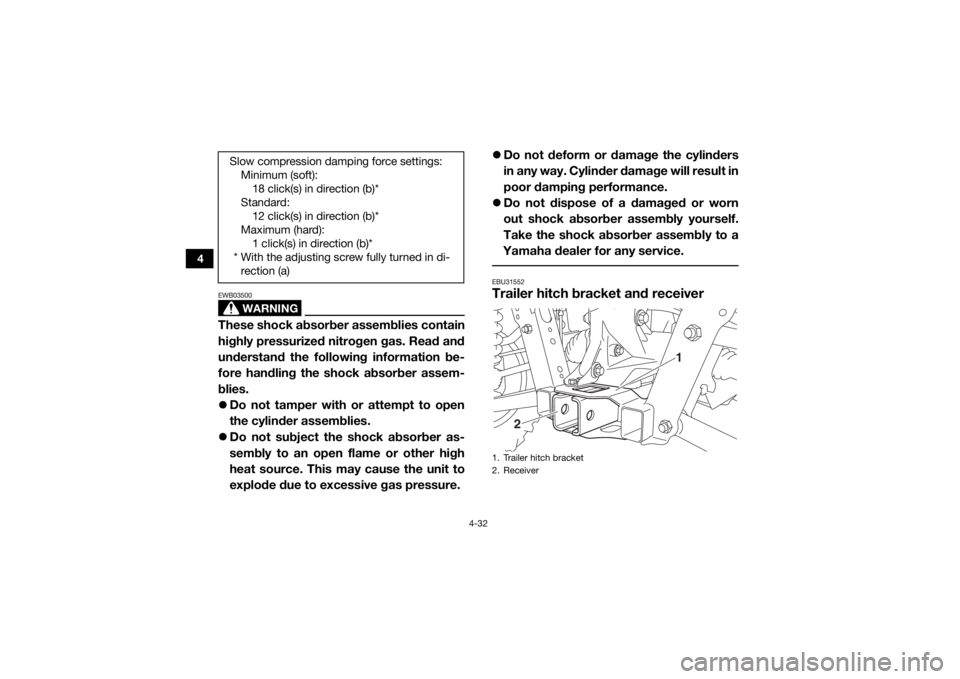
4-32
4
WARNING
EWB03500These shock absorber assemblies contain
highly pressurized nitrogen gas. Read and
understand the following information be-
fore handling the shock absorber assem-
blies.
Do not tamper with or attempt to open
the cylinder assemblies.
Do not subject the shock absorber as-
sembly to an open flame or other high
heat source. This may cause the unit to
explode due to excessive gas pressure.
Do not deform or damage the cylinders
in any way. Cylinder damage will result in
poor damping performance.
Do not dispose of a damaged or worn
out shock absorber assembly yourself.
Take the shock absorber assembly to a
Yamaha dealer for any service.
EBU31552Trailer hitch bracket and receiver
Slow compression damping force settings: Minimum (soft):18 click(s) in direction (b)*
Standard: 12 click(s) in direction (b)*
Maximum (hard): 1 click(s) in direction (b)*
* With the adjusting screw fully turned in di- rection (a)
1. Trailer hitch bracket
2. Receiver
1
2
UB3D7AE0.book Page 32 Tuesday, November 7, 2017 9:38 AM